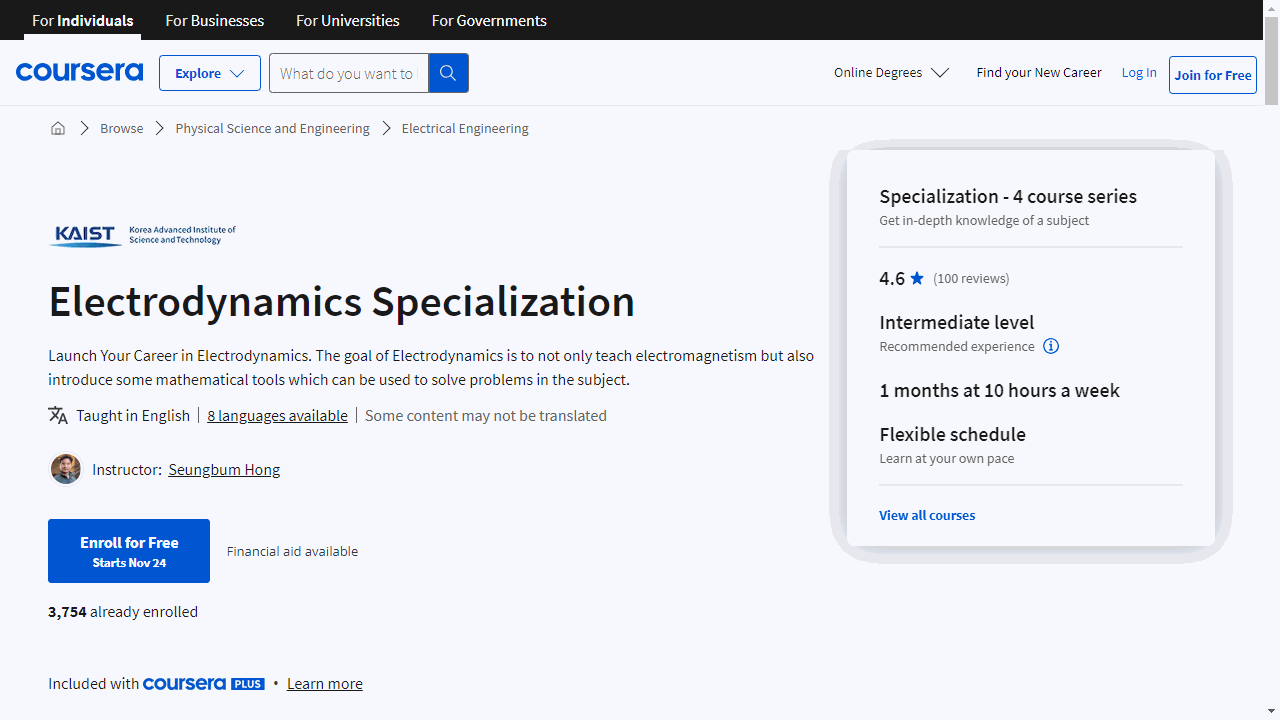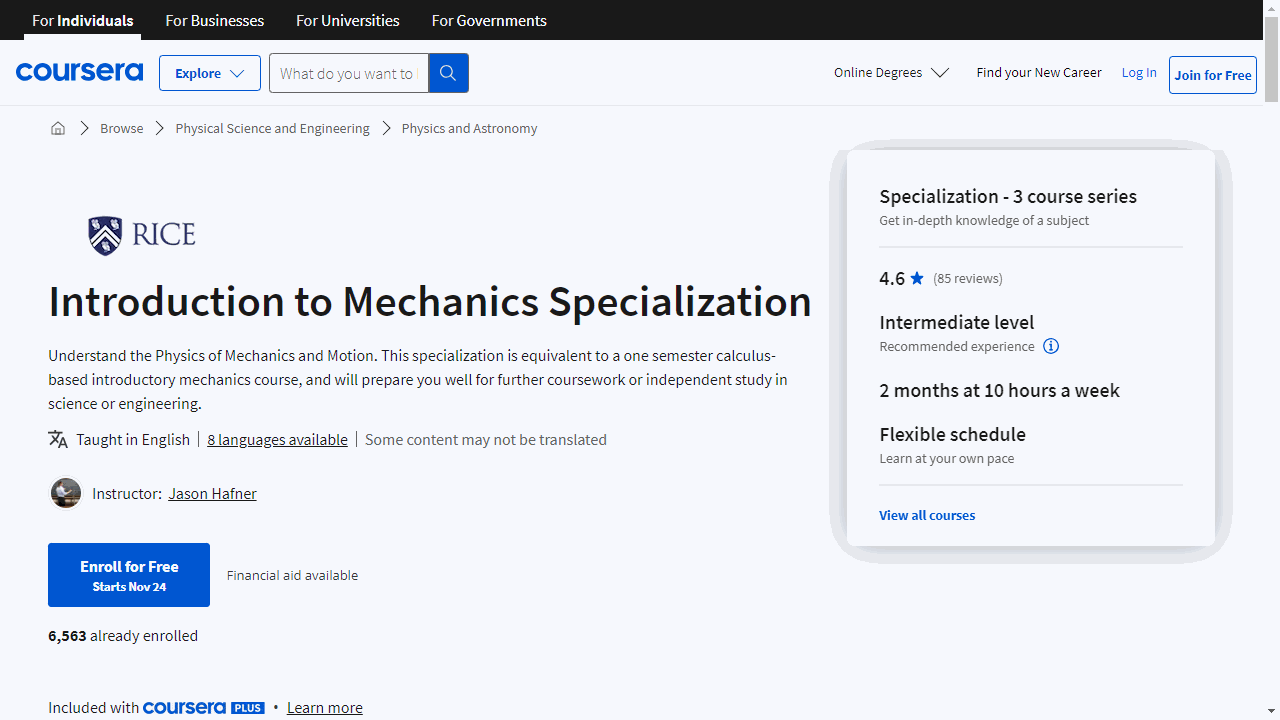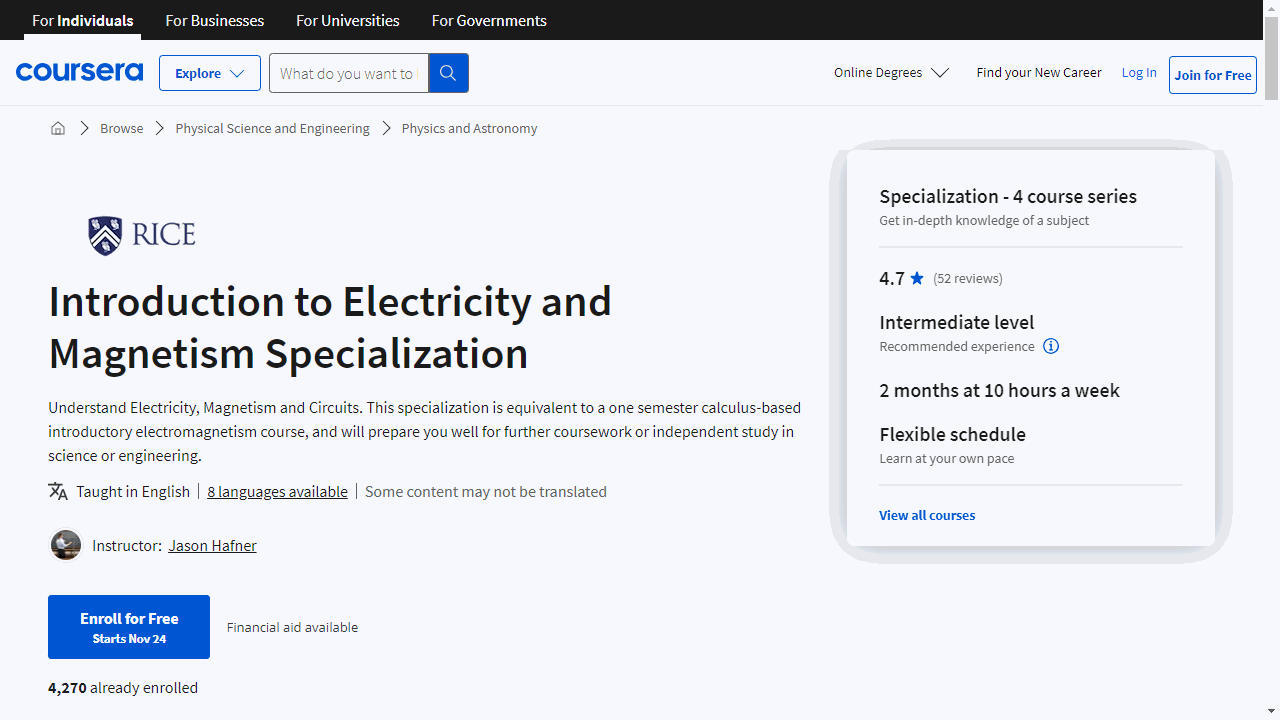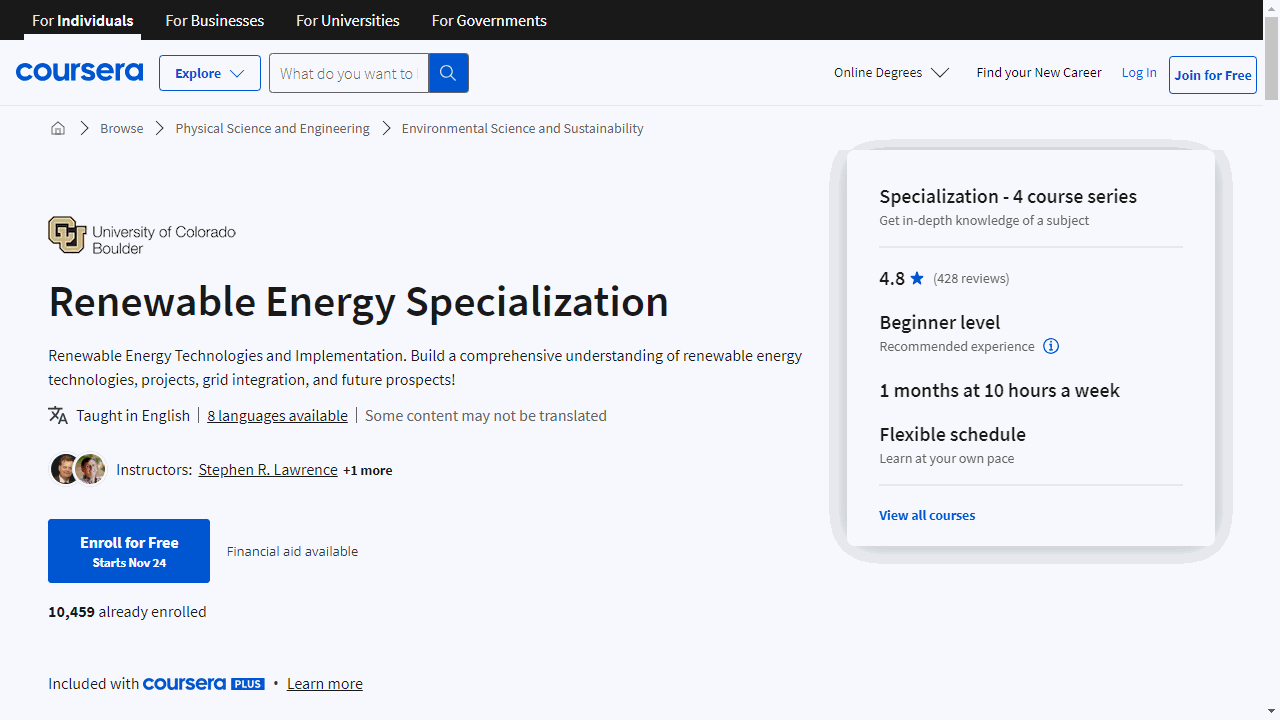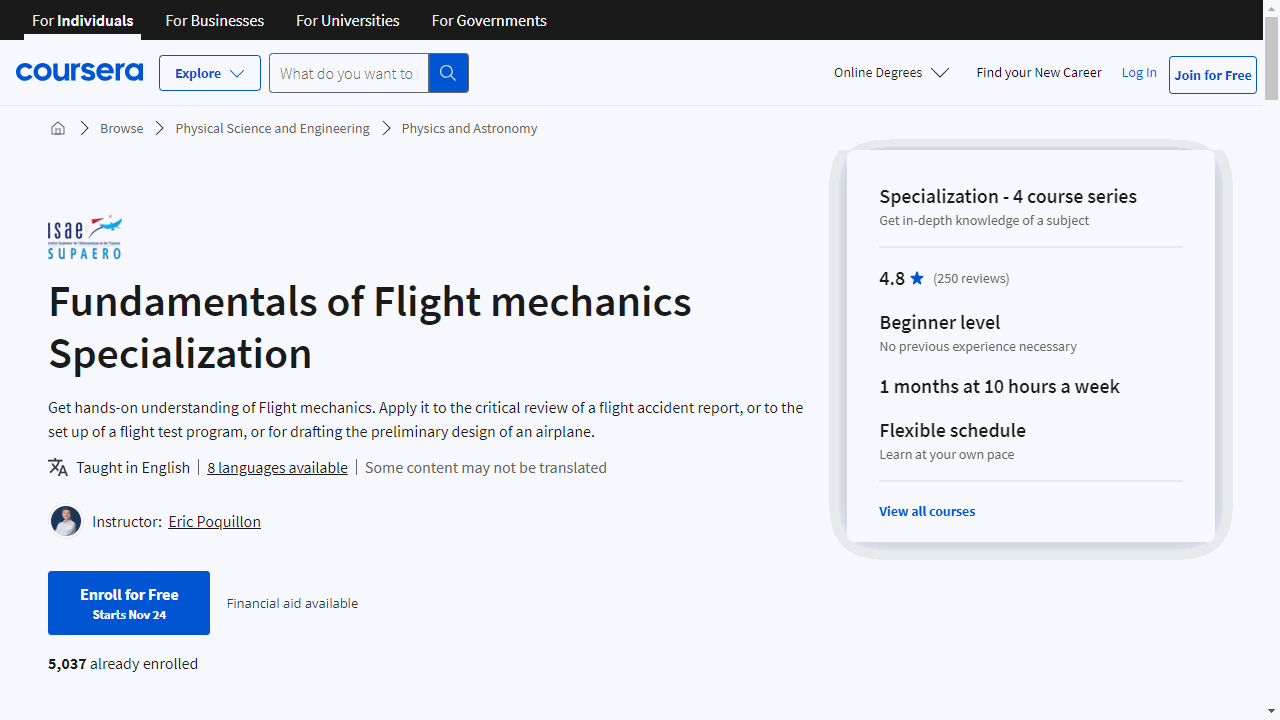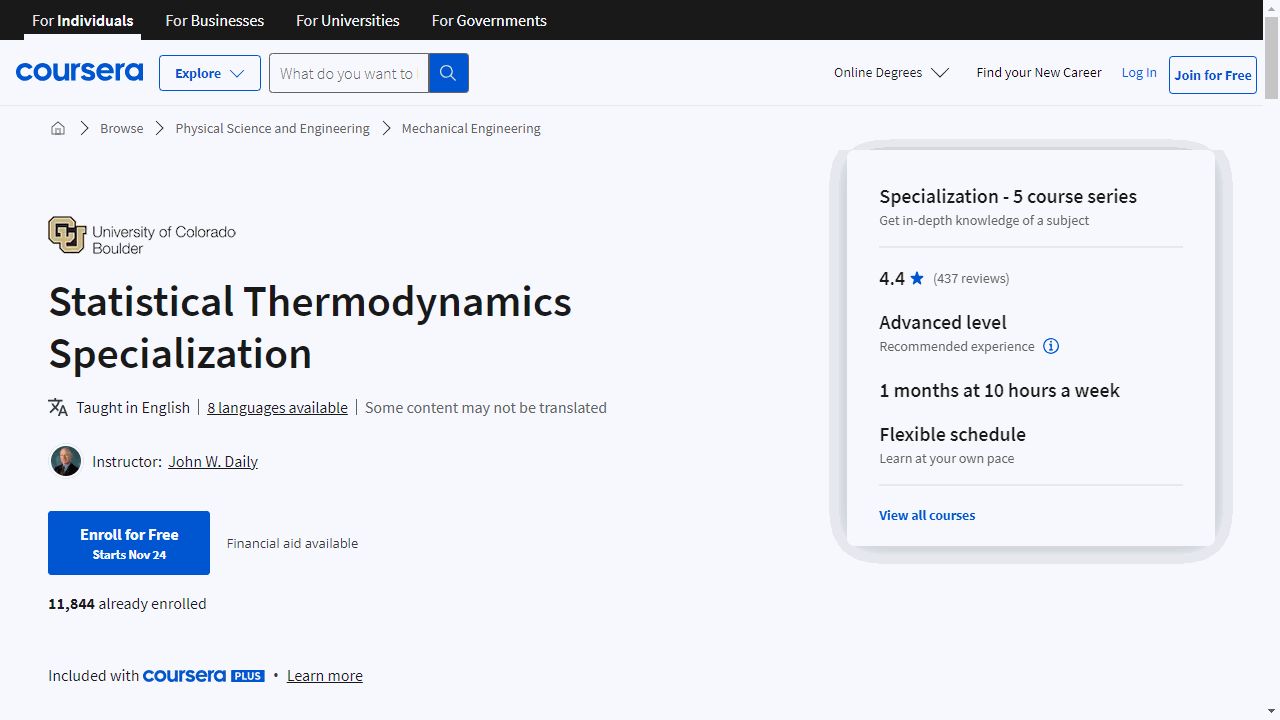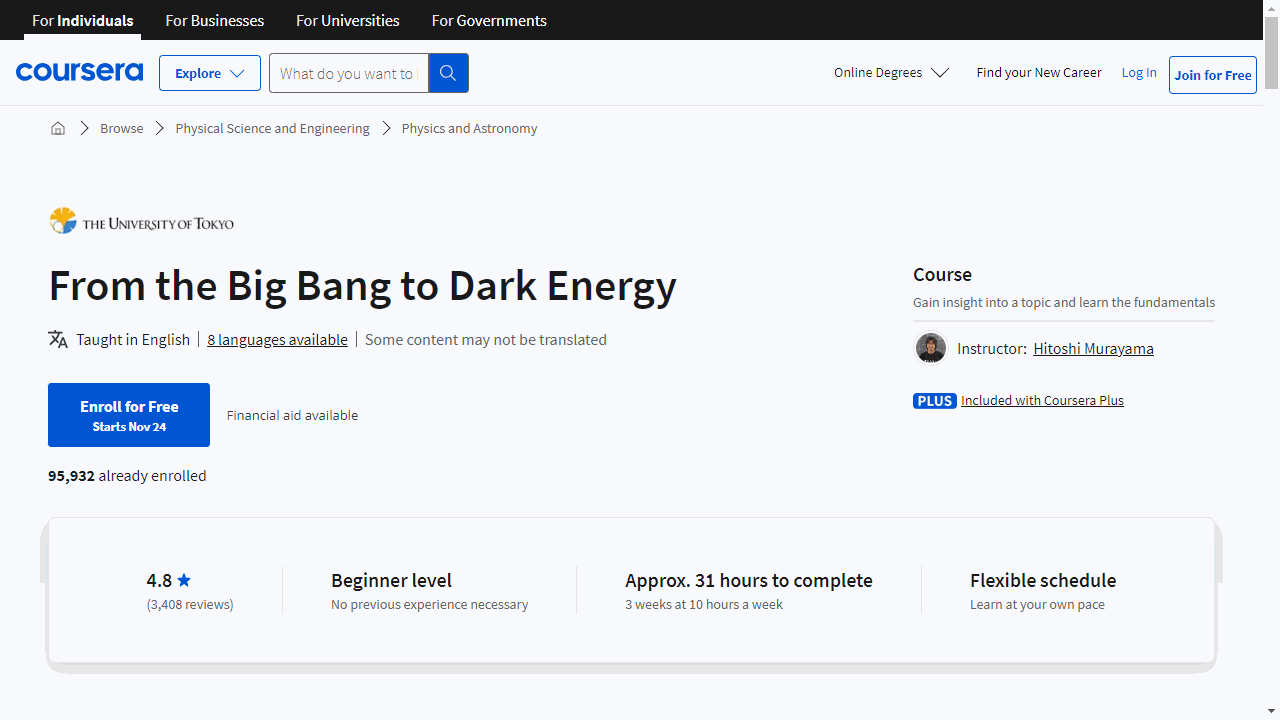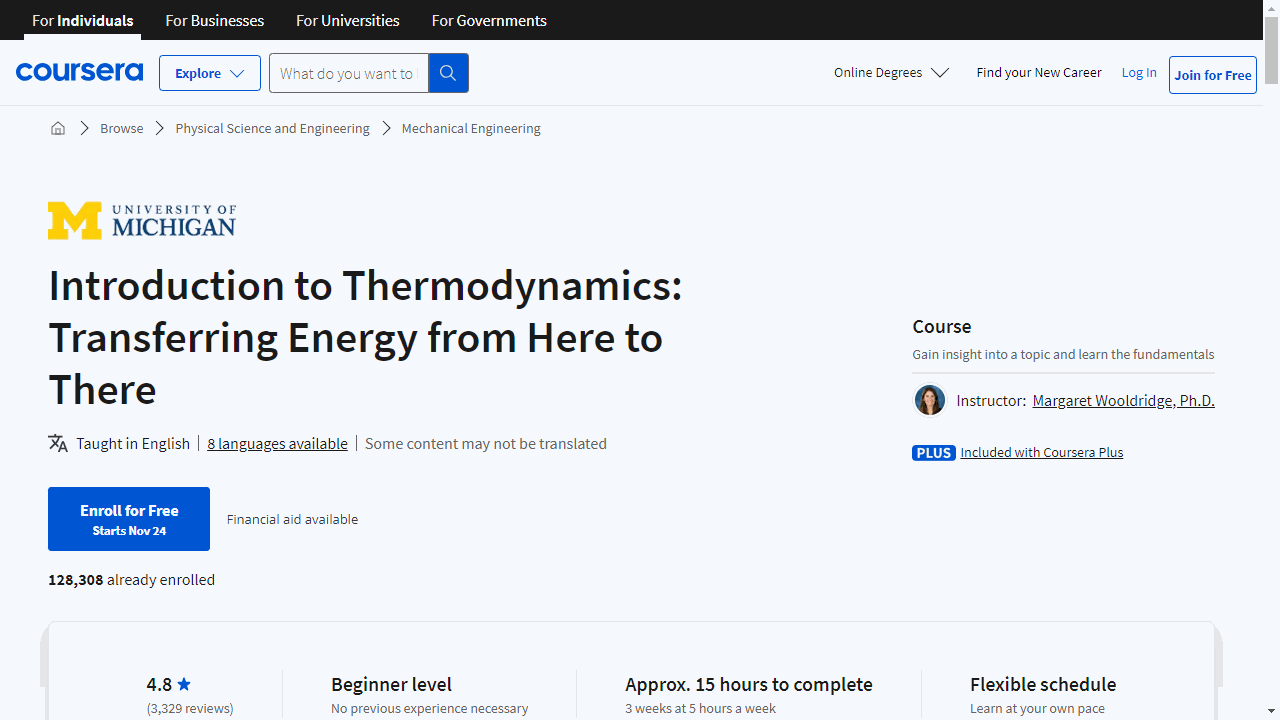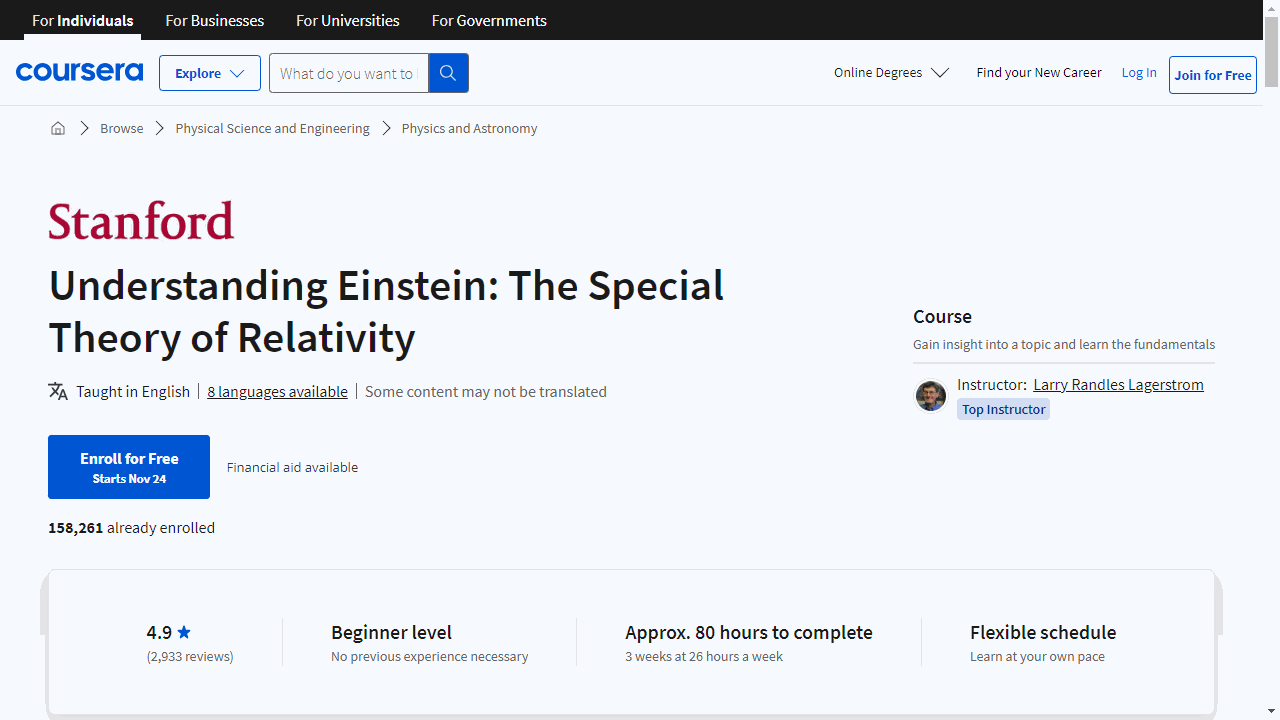Physics is a fundamental science that governs the behavior of the universe, from the smallest particles to the largest galaxies.
By understanding physics, you can unlock the secrets of motion, energy, and matter, equipping you to solve complex problems and make informed decisions in fields ranging from engineering to medicine.
Whether you’re a budding scientist, a curious learner, or simply seeking a deeper understanding of the world around you, a solid foundation in physics can be invaluable.
Finding a comprehensive and engaging physics course can be a daunting task, with so many options available online.
You want a course that’s both challenging and accessible, taught by experts, and tailored to your learning style.
For the best physics course overall on Coursera, we recommend “Introduction to Mechanics Specialization” by Rice University.
This specialization provides a comprehensive introduction to the fundamentals of mechanics, covering topics such as kinematics, forces, energy, momentum, and rotational motion.
The course features engaging video lectures, interactive quizzes, and real-world problem-solving exercises, making it an ideal choice for both beginners and those seeking to refresh their knowledge.
This is just the tip of the iceberg when it comes to quality physics courses on Coursera.
Keep reading to discover more options, tailored to specific areas of physics, learning levels, and even career goals.
Introduction to Mechanics Specialization
This series is crafted to build your understanding of physics from the ground up, with a focus on practical problem-solving skills that mirror real-world scenarios.
The journey begins with “Physics 101 - Forces and Kinematics,” where you’ll grasp the fundamentals of motion.
Through engaging video lectures and interactive quizzes, you’ll master 1D and 2D Kinematics and Newton’s Laws, employing tools like algebra and calculus.
The course is designed to be hands-on, with free textbook resources and homework problems that ensure you’re not just passively learning but actively applying your knowledge.
Progressing to “Physics 101 - Energy and Momentum,” you’ll delve into the concepts of mechanical energy and momentum.
This course demystifies the principles governing energy transfer and object interactions, with a special emphasis on real-life applications like collisions and material elasticity.
The structured modules guide you through each concept, culminating in an exam that benchmarks your proficiency.
The final course, “Physics 101 - Rotational Motion and Gravitation,” rounds out your foundational physics education.
Here, you’ll explore the intricacies of angular momentum and the universal law of gravitation.
The course content, which includes rotational motion and the forces that govern planetary orbits, is delivered through comprehensive lectures and problem sets that challenge and expand your understanding.
Each course in the specialization mirrors the rigor of Rice University’s on-campus offerings, ensuring you receive a high-quality education.
Upon completion, you’ll not only be equipped to tackle advanced physics courses but also possess a robust framework for analyzing motion and energy in any context.
Introduction to Electricity and Magnetism Specialization
Start with “Physics 102 - Electric Charges and Fields,” where you’ll delve into the fundamentals of electric forces and fields.
Through interactive problem-solving and quizzes, you’ll apply mathematical concepts to real-world scenarios, laying a solid foundation for more complex topics.
Progress to “Physics 102 - Electric Potential and DC Circuits,” which demystifies the energy dynamics in electric potential and capacitors, and the principles governing DC circuits.
The course’s practical approach ensures you’re not just passively learning; you’re actively engaging with the material.
In “Physics 102 - Magnetic Fields and Faraday’s Law,” you’ll explore the intriguing concepts of magnetic fields and inductive laws.
This course brings these invisible forces to life, enhancing your understanding through targeted problem sets and assessments.
Finally, “Physics 102 - AC Circuits and Maxwell’s Equations” rounds out your education with a focus on alternating current systems and the foundational Maxwell’s Equations.
By the end of this course, you’ll have a comprehensive grasp of electromagnetism’s role in modern technology.
Each course is enriched with free textbook readings, full video lectures, and conceptual quizzes, culminating in an exam to consolidate your learning.
Electrodynamics Specialization
The specialization starts with the “Electrodynamics: An Introduction” course is your first step into the realm of electromagnetism, laying a solid foundation with vector calculus and electrostatics.
This isn’t just theory; it’s about connecting the dots to real-world applications like energy storage.
Progressing to “Electrodynamics: Analysis of Electric Fields,” you’ll sharpen your skills in calculating electric fields and delve into polarization and dipoles.
As you advance to “Electrodynamics: Electric and Magnetic Fields,” magnetostatics comes into play, linking to prior knowledge and introducing electromotive force.
The final leap in this series, “Electrodynamics: In-depth Solutions for Maxwell’s Equations,” challenges you to tackle complex systems and AC circuits.
This course goes beyond the basics, offering a comprehensive understanding of Maxwell’s Equations in dynamic scenarios.
Each course is meticulously crafted to ensure a seamless transition from theory to application, enriched with Feynman’s insightful approach to physics.
Renewable Energy Specialization
This specialization is a practical, in-depth series that equips you with the knowledge to understand and contribute to the renewable energy sector.
It begins with “Renewable Energy Technology Fundamentals,” where you’ll gain a solid grasp of wind and solar technologies, as well as energy storage systems like batteries and hydrogen.
This foundational course sets the stage for you to engage in discussions and make informed decisions in the renewable energy space.
Moving on to “Renewable Power and Electricity Systems,” you’ll delve into the workings of electricity systems and the integration of renewable sources.
It’s not just about the mechanics; you’ll also explore the market forces driving the shift towards sustainable energy, preparing you to be part of this global transformation.
In “Renewable Energy Projects,” the focus shifts to application.
You’ll learn to navigate the entire lifecycle of renewable energy projects, from feasibility studies to operational management.
This course is crucial for those looking to lead and execute in the field of renewable energy deployment.
Lastly, “Renewable Energy Futures” offers a forward-looking perspective, examining emerging technologies and their interplay with renewables.
You’ll gain insights into the trajectory of renewable energy and its synergies with sectors like electric vehicles and energy storage.
Each course is rich with relevant skills, from project management to understanding the intricacies of energy systems.
Fundamentals of Flight Mechanics Specialization
If you’re intrigued by the physics of flight, the “Fundamentals of Flight Mechanics Specialization” on Coursera offers a clear and engaging path to understanding how aircraft operate.
This series of courses is designed to demystify the principles of flight, making complex concepts accessible to all learners, regardless of their math skills.
In “Flight Mechanics - The Basis,” you’ll start by learning the vocabulary of aviation and the fundamental principles that govern an aircraft’s movement.
The course emphasizes practical understanding, using visual aids to complement the technical aspects, ensuring you can grasp the material even if you skip the math.
Moving on to “Flight Mechanics - Anemobarometry,” you’ll delve into atmospheric physics and its impact on flight.
This course clarifies how pilots interpret speed and altitude readings, and why understanding the atmosphere is crucial for safe flying.
It’s not just about numbers; it’s about real-world application and safety.
The third course, “Flight Mechanics - Lift and Trajectory,” focuses on the concept of lift.
You’ll explore how speed and angle of attack influence an aircraft’s ability to stay airborne and learn about flight limitations such as stalls and flutter.
This knowledge is vital for anyone interested in the operational aspects of flying.
Lastly, “Flight Mechanics - Propulsive Balance and Energy” covers the essentials of energy management in aviation.
You’ll examine the interplay between drag and thrust and how they affect an aircraft’s speed and altitude.
This course provides insights into the mechanics of efficient flight and the factors that pilots must manage to ensure a smooth journey.
Each course in this specialization is rich with technical details yet presented in a way that’s digestible for learners at all levels.
Whether you’re a student, a professional, or simply a physics enthusiast, these courses will deepen your understanding of the forces at play in the skies above.
Statistical Thermodynamics Specialization
Starting with “Fundamentals of Macroscopic and Microscopic Thermodynamics,” you’ll delve into the core principles like temperature and pressure.
This course demystifies the link between the microscopic world of molecules and the macroscopic properties we observe, setting a solid foundation for your journey.
Moving on to “Quantum Mechanics,” the specialization takes a leap into the quantum realm.
You’ll tackle the Schrödinger wave equation and gain insights into atomic behavior.
The course simplifies complex quantum chemistry, providing you with practical skills to solve quantum problems.
“Ideal Gases” shifts the focus to systems where intermolecular forces take a backseat.
You’ll explore various gas behaviors and their industrial relevance, learning to predict how gases will respond under different conditions using partition functions.
In “Dense Gases, Liquids and Solids,” the course examines what happens as gases condense.
You’ll understand the transition from gas to liquid and solid states, and learn to use the radial distribution function to analyze liquid properties.
Lastly, “Non-Equilibrium Applications of Statistical Thermodynamics” applies your knowledge to dynamic systems.
From gas transport properties to the intricacies of chemical kinetics, this course covers essential topics like spectroscopy and computational tools for kinetic calculations.
From the Big Bang to Dark Energy
If you’re eager to unravel the mysteries of the cosmos, this course is a must.
It’s a comprehensive journey through the fundamental concepts of physics, tailored to ignite your curiosity and deepen your understanding of the universe.
The course kicks off with the essentials, explaining the mechanics behind night and day, the seasons, and the elliptical orbit of Earth.
It’s a practical start, grounding you in the phenomena you experience daily.
As you progress, the course delves into the origins of the universe with a series of lessons on cosmic expansion.
You’ll learn how observing distant galaxies allows us to peer back in time, providing clues to the universe’s infancy.
The narrative then shifts to the birth of elements, tracing the origins of matter from the simplest atoms to the building blocks of life.
The course also demystifies the Higgs Boson, shedding light on its crucial role in the fabric of space and time.
Dark matter and dark energy are next on the agenda, enigmatic components of the universe that dictate the structure of galaxies and the rate of cosmic expansion.
These lessons offer a window into the cutting-edge research that’s reshaping our understanding of the cosmos.
If you enjoy a good challenge, optional problems are available to test your knowledge and apply the concepts learned.
In the latter part of the course, you’ll explore the fate of the universe, including theories like the Big Rip and the role of dark energy in cosmic destiny.
It’s a thought-provoking segment that encourages you to ponder the ultimate questions of existence.
The course is rounded out with extra lectures on groundbreaking discoveries like gravitational waves and black holes, providing a comprehensive view of modern physics.
“From the Big Bang to Dark Energy” is more than just a physics course; it’s an intellectual adventure that equips you with a deeper appreciation for the universe’s wonders.
Introduction to Thermodynamics: Transferring Energy from Here to There
From the get-go, the course tackles the pressing need to rethink our energy usage, grounding you in the practicalities of energy and power.
You’ll quickly become familiar with the concepts of open and closed systems, key to understanding energy dynamics.
The curriculum brings thermodynamic properties to life, setting the stage for exploring work transfer mechanisms through tangible examples, such as air compression.
The First Law of Thermodynamics will be demystified, revealing the principles of energy conservation in closed systems.
Practical applications abound, with phase diagrams and heat transfer processes made accessible.
You’ll dissect steam turbines and delve into the conservation of mass for open systems, gaining insights into real-world engineering challenges.
The course bravely tackles complex ideas, offering a clear introduction to the Second Law of Thermodynamics and examining power cycles like Carnot and Rankine, central to modern power generation.
You’ll conduct a thorough analysis of a Rankine Power Plant, gaining a behind-the-scenes look at electricity production.
Future-focused topics are also on the agenda, including waste heat recovery and the quest for improved thermal efficiencies.
The course even takes you inside a jet engine and discusses the Brayton Cycle, linking thermodynamics to cutting-edge technology.
Environmental considerations are woven throughout, with discussions on carbon reserves, global warming, and energy carriers, emphasizing the role of thermodynamics in addressing these global challenges.
By the end of this course, you’ll have a robust understanding of thermodynamics, equipped to see the world through the lens of energy transfer.
Understanding Einstein: The Special Theory of Relativity
This course, offered by Stanford University, begins with a math review to ensure you’re equipped with the necessary tools, setting a strong foundation for what’s to come.
The course narrative unfolds with a look at Einstein’s early life, leading up to his groundbreaking work in 1905.
You’ll explore key concepts like events, clocks, and observers, and learn to navigate spacetime diagrams, which are essential for visualizing relativity.
Week 2 introduces the Galilean transformation, providing historical context before Einstein’s theories reshaped our understanding of motion.
As you progress to Week 3, you’ll dissect the Michelson-Morley experiment, debunking the ether theory and setting the stage for modern physics.
The fourth week delves into the peculiarities of time dilation and length contraction, using tangible examples like the behavior of muons to illustrate these phenomena.
The course continues to build momentum in Week 5, where you’ll examine the Lorentz transformation and confront the cosmic speed limit: the speed of light.
In Week 6, spacetime diagrams come back into play, now with a deeper analysis of causality and the implications of superluminal speeds.
Week 7 tackles paradoxes such as the “pole in the barn” and the “twin paradox,” challenging your understanding and offering profound insights into the nature of space and time.
The course culminates in Week 8 with discussions on interstellar travel and the implications of E=mc², Einstein’s most famous equation.
You’ll leave with a sense of how Einstein’s “happiest thought” led to the concept of light bending under gravity.
With optional problem sets available for practice, and solutions to reinforce your learning, the course is designed to be interactive and engaging.
And if you are left hungry for more knowledge, a curated reading list is provided for further exploration.
Also check our posts on:
